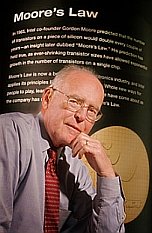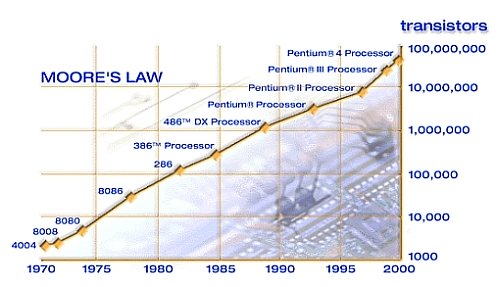|
| ||
|
| ||
What is Moores Law? Moore's law is named after Gordon E. Moore -- co-founder and Chairman Emeritus of Intel Corporation. (Image Copyright Intel Corporation) Gordon Moore first published what later became known as Moore's Law in a 1965 Electronics Magazine article called Cramming more components onto integrated circuits. Moore's Law states that the number of transistors that can be placed on an integrated circuit for the same price will increase exponentially by a factor of 2 every 18 to 24 months. In other words, put simply Moore's Law claims that CPU processing power will double approximately every two years for the price of 1,000 dollars. (Graph copyright Ray Kurzweil)
Today Moore's law is also known as the law of exponential growth or the accelerating change law (also known as the accelerated change law). Yet despite its relatively wide publicity most people fail to comprehend its immense power and profound implications. For example, there is an ancient Indian legend about the origins of Paal Paysam (or rice pudding) which is often quoted as a good case of the often underestimated power of exponential growth. The most important and controversial implication of Moore's Law has often been described by futurists such as Ray Kurzweil and Vernor Vinge who believe that exponential growth trends such as Moore's Law will eventually lead to a Technological Singularity. For example, in the Law of Accelerating Returns Ray Kurzweil argues that Moore's Law is only one representation of the exponential growth in computing power in particular and the evolution of technology in general: "Moore's law of Integrated Circuits was not the first, but the fifth paradigm to forecast accelerating price-performance ratios. Computing devices have been consistently multiplying in power (per unit of time) from the mechanical calculating devices used in the 1890 U.S. Census, to [Newman's] relay-based "[Heath] Robinson" machine that cracked the Nazi [Lorenz cipher], to the CBS vacuum tube computer that predicted the election of Eisenhower, to the transistor-based machines used in the first space launches, to the integrated-circuit-based personal computer."
It seems that, while Gordon Moore was arguably the first to note the exponential growth in computing power, this exponential trend has been a part of technological progress for much longer than originally thought. Some of the main issues here are: Will Moore's Law continue to hold true? For how long? Does Moore's Law (or exponential growth in general) apply in areas other than technology? If yes, then, what does it mean for the future of humanity? Do you want to sumbit your own singularity content?Do you agree or disagree with the content of this page? Do you want to improve it? Do you want to post some great singularity content of your own? Why not share it here at Singularity Symposium?! What Other Visitors Have SaidClick below to see contributions from other visitors to this page...
Believing the unbelievable
Standard growth model Not rated yet Return from Moore's Law to Singularity Symposium Home |
|
|
|
| ||
Internet gems
| ||
|
Copyright © 2012 - www.SingularitySymposium.com - All Rights Reserved
| ||







